
Geleznowia is a monotypic genus of a flowering plant in the family Rutaceae. It is a small shrub with oval-shaped leaves, yellow flowers and is endemic to Western Australia. Its only species is Geleznowia verrucosa.
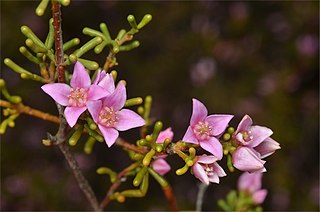
Boronia inornata, commonly known as desert boronia, is a plant in the citrus family, Rutaceae and is endemic to southern Australia. It is an erect shrub with three-part leaves and pink, red or white, four-petalled flowers.

Boronia pulchella, commonly known as the pink boronia, is a plant in the citrus family Rutaceae, and is endemic to a small area in the south-west of Western Australia. It is a slender shrub with rod-like stems, pinnate leaves and deep pink, four-petalled flowers.
Phebalium microphyllum is a species of small, rounded shrub that is endemic to Western Australia. It has scaly branchlets, leathery, oblong leaves and yellow flowers arranged in umbels of three to six on the ends of branchlets.

Hibbertia mucronata is a species of flowering plant in the family Dilleniaceae and is endemic to the south of Western Australia. It is an erect shrub with hairy branches, crowded, thick, tapering linear leaves ending in a sharp point, and golden yellow flowers with five stamens fused at their bases, all on one side of two densely hairy carpels.
Bossiaea divaricata is a species of flowering plant in the family Fabaceae and is endemic to the southwest of Western Australia. It is a low, dense, openly-branched shrub with oblong to egg-shaped leaves and deep yellow and dark red flowers.
Bossiaea peduncularis is a species of flowering plant in the family Fabaceae and is endemic to Western Australia. It is an erect, more or less leafless shrub with arching branches, cladodes ending with a point and deep yellow, red and greenish-yellow flowers.
Pultenaea spinulosa is a species of flowering plant in the family Fabaceae and is endemic to the south of Western Australia. It is a shrub with flat, hairy leaves, and uniformly yellow flowers.
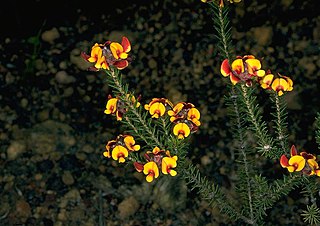
Pultenaea verruculosa is a species of flowering plant in the family Fabaceae and is endemic to the south-west of Western Australia. It is an erect shrub with flat, hairy leaves, and yellow-orange and red, pea-like flowers.
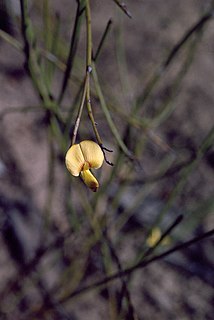
Daviesia anceps is a species of flowering plant in the family Fabaceae and is endemic to the south of Western Australia. It is a dense, erect or low-lying shrub with its branchlets reduced to flattened cladodes, and yellow flowers with red markings.
Conostephium drummondii is a species of flowering plant in the family Ericaceae and is endemic to the south-west of Western Australia. It is a slender, erect or spreading shrub that typically grows to a height of 0.3–1.5 m. It is a variable species with multi-coloured flowers from March to July or from November to December.

Lasiopetalum quinquenervium is a species of flowering plant in the family Malvaceae and is endemic to the south of Western Australia. It is an erect, spreading shrub with hairy stems and leaves, egg-shaped leaves and pink or white flowers.

Lasiopetalum rosmarinifolium is a species of flowering plant in the family Malvaceae and is endemic to the south-west of Western Australia. It is an erect or spreading shrub with hairy stems and leaves, linear leaves and white flowers.
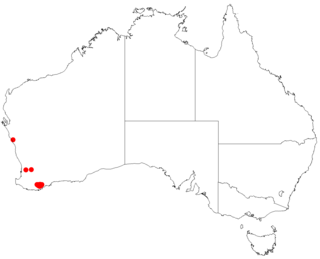
Leucopogon atherolepis is a species of flowering plant in the family Ericaceae and is endemic to the south-west of Western Australia. It is an erect shrub with linear leaves and white, tube-shaped flowers.

Spyridium cordatum is a species of flowering plant in the family Rhamnaceae and is endemic to the south-west of Western Australia. It is a prostrate, straggling or ascending shrub with leathery, broadly heart-shaped leaves with a notched tip, 2–4 mm (0.079–0.157 in) long with woolly, white or rust-coloured hairs on the lower side. The heads of flowers are 6.5–8.5 mm (0.26–0.33 in) wide with two to four floral leaves at the base. The sepals are up to 1.6 mm (0.063 in) long the petal tube shaggy-hairy with more or less glabrous lobes.

Mirbelia multicaulis is a species of flowering plant in the family Fabaceae and is endemic to the south-west of Western Australia. It is an erect, rigid shrub that typically grows to a height of 15–50 cm (5.9–19.7 in) and has erect stems with few branches. It has scattered, egg-shaped to oblong leaves 4–6 mm (0.16–0.24 in) long and spines that are longer than the leaves. The flowers are arranged in clusters in leaf axils or at the base of the spines and are yellow or orange and reddish-brown and appear in September and October. It was first formally described in 1853 by Nikolai Turczaninow who gave it the name Dichosema multicaule in the Bulletin de la Société Impériale des Naturalistes de Moscou. In 1864, George Bentham changed the name to Mirbelia multicaulis in Flora Australiensis. The specific epithet (multicaulis) means "many stems".

Leucopogon cuneifolius is a species of flowering plant in the heath family Ericaceae and is endemic to Western Australia. It is an erect, bushy shrub that typically grows to a height of 0.2–1.5 m. Its leaves are egg-shaped to lance-shaped with the narrower end towards the base, about 6 mm (0.24 in) long with a distinct petiole. Up to 3 flowers are borne in upper leaf axils on a short peduncle, with small bracts and bracteoles at the base. The sepals are about 3 mm (0.12 in) long and the petals about 5 mm (0.20 in) long, the petal lobes much shorter than the petal tube.
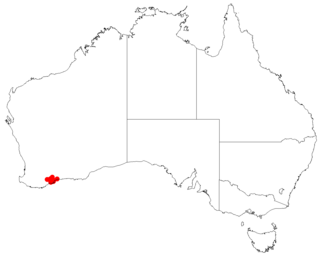
Leucopogon decussatus is a species of flowering plant in the heath family Ericaceae and is endemic to the south-west of Western Australia. It is an erect shrub that typically grows to a height of about 40 cm (16 in). It was first formally described in 1859 by Sergei Sergeyevich Sheglejev in the Bulletin de la Société impériale des naturalistes de Moscou. The specific epithet (decussatus) means "decussate".

Mirbelia subcordata is a species of flowering plant in the family Fabaceae and is endemic to the south-west of Western Australia. It is an erect, spreading shrub with egg-shaped to lance-shaped leaves and yellow or orange and red flowers.

Leucopogon fimbriatus is a species of flowering plant in the heath family Ericaceae and is endemic to the south-west of Western Australia. It is a bushy, erect or sprawling shrub with overlapping egg-shaped or oblong leaves and spikes of tube-shaped white flowers on the ends of branches.
















